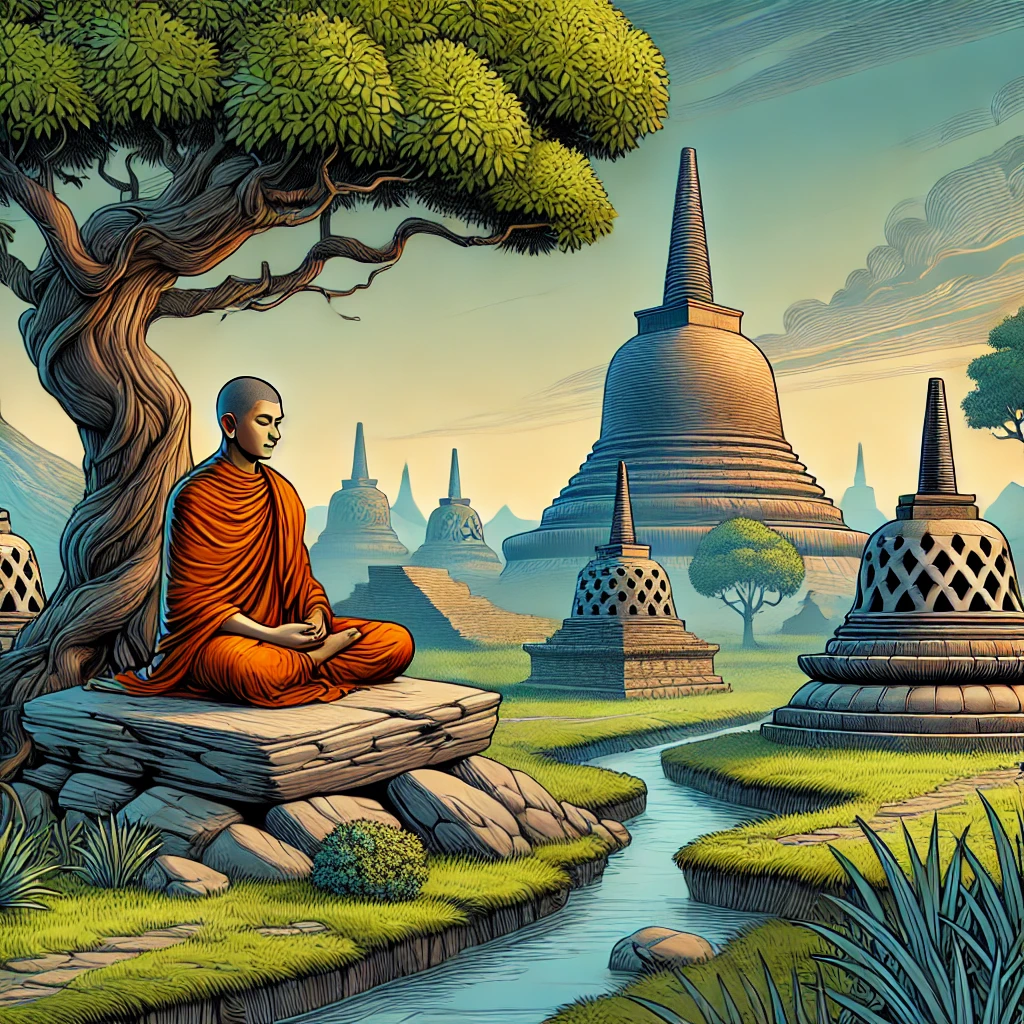Buddhism is one of the major world religions. It originated in India around the 6th century BCE with the teachings of Siddhartha Gautama, known as the Buddha. Over the centuries, Buddhism evolved into various schools. Hinayana (often referred to as Theravada in modern contexts) is one of the earliest and most influential. Hinayana Buddhism, also known as Theravada Buddhism, is one of the oldest and most traditional branches of Buddhism. It is rooted in the earliest teachings of the Buddha. It emphasizes personal enlightenment through individual effort, strict adherence to monastic rules, and a disciplined way of life. The term “Hinayana,” meaning “lesser vehicle,” was historically used by Mahayana Buddhists to differentiate their practices from those of Theravada. It is considered derogatory by some.
Hinayana Buddhism predominantly flourishes in countries such as Sri Lanka, Thailand, Myanmar, Laos, and Cambodia. It maintains the Pali script as its primary scriptural source. It is believed to be the closest representation of the original teachings of the Buddha. The central focus of Hinayana practice is the attainment of Nirvana through the Eightfold Path. It emphasizes ethical conduct, meditation, and wisdom.
The monastic community, or Sangha, plays a crucial role in Hinayana Buddhism. Monks and nuns dedicate their lives to study, meditation, and teaching the Dharma to lay followers. Lay Buddhists support the monastic community through other acts of generosity, which are considered essential for cultivating merit. The interdependence between the monastic and lay communities forms the foundation of Hinayana Buddhist practice. It sustains its traditions across generations.

What is Hinayana Buddhism: Origin and Development
Hinayana Buddhism, or Theravada Buddhism, originated from the early teachings of the Buddha in the 5th century BCE. It developed through the First Buddhist Council, where his teachings were orally preserved and later written in the Pali script. This tradition emphasizes personal enlightenment through individual effort and strict adherence to monastic rules. As Buddhism spread across Asia, Theravada established itself in Sri Lanka, Southeast Asia, and parts of India. Over time, it evolved with regional influences but maintained its core focus on the original teachings and practices of the Buddha.
Early Buddhism and the First Division
After the death of the Buddha around 483 BCE, his teachings were orally transmitted by his disciples. The first significant split occurred during the Second Buddhist Council around 383 BCE, primarily over disciplinary rules (Vinaya). This led to the division into the Sthaviravada (meaning “Way of the Elders”) and the Mahasanghika.
Consolidation of Hinayana
Hinayana Buddhism consolidated itself during the Third Buddhist Council under the patronage of Emperor Ashoka around 250 BCE. This council led to the reaffirmation of the original teachings of the Buddha. It emphasized a practical and disciplined approach to enlightenment. It also marked the beginning of Buddhist missionary activities, spreading Buddhism to other parts of Asia.
Difference Between Hinayana Buddhism and Mahayana Buddhism
Hinayana and Mahayana are the two major branches of Buddhism, each with distinct philosophies and practices. Hinayana, also known as Theravada Buddhism, emphasizes personal enlightenment and adheres closely to the original teachings of Buddha. It focuses on individual efforts to achieve Nirvana through rigorous meditation, ethical conduct, and adherence to the Pali Canon. Hinayana Buddhists view the Buddha as a great teacher and guide, not as a divine figure.
In contrast, Mahayana Buddhism expands the scope of enlightenment to include all beings. It emphasizes the Bodhisattva ideal, where practitioners strive to attain Buddhahood for the benefit of all sentient beings. Mahayana texts, such as the Mahayana Sutras, introduce concepts like emptiness (Śūnyatā) and the idea of multiple Buddhas and Bodhisattvas. This branch sees the Buddha as a transcendent, almost divine figure who remains accessible to help others achieve enlightenment.
While Hinayana practices are more conservative and monastic, focusing on meditation and wisdom, Mahayana is more inclusive, incorporating various rituals, prayers, and the use of devotional images and icons. Despite these differences, both branches share a common foundation in the teachings of Siddhartha Gautama, the Buddha, and aim toward the ultimate goal of liberation from suffering.
Core Teachings of Hinayana Buddhism
Hinayana Buddhism, or Theravada Buddhism, centers on the core teachings of the Buddha as recorded in the Pali script. Its fundamental principles include the Four Noble Truths and the Noble Eightfold Path. Theravada emphasizes personal effort in achieving enlightenment, the practice of mindfulness and meditation, and adherence to the Vinaya, a code of monastic discipline. The ultimate goal is to attain Nirvana, a state of liberation from the cycle of birth, death, and rebirth.
The Four Noble Truths
1. The Truth of Suffering (Dukkha): Recognizes that life is inherently unsatisfactory and full of suffering.
2. The Truth of the Cause of Suffering (Samudaya): Identifies desire and attachment as the primary causes of suffering.
3. The Truth of the End of Suffering (Nirodha): Suggests that by eliminating desire, suffering can also be eliminated.
4. The Path Leading to the End of Suffering (Magga): Outlines the Eightfold Path as a means to achieve enlightenment.
The Eightfold Path
The Eightfold Path is a fundamental teaching in Buddhism. They represent the practical approach to ending suffering (Dukkha) and achieving enlightenment (Nirvana). This path, also known as the Middle Way, avoids the extremes of self-indulgence and self-mortification. It is divided into three main categories: Wisdom (Prajna), Ethical Conduct (Sila), and Mental Discipline (Samadhi). Following are the 8 fundamental teachings:
- Right Understanding
- Right Thought
- Right Speech
- Right Action
- Right Livelihood
- Right Effort
- Right Mindfulness
- Right Concentration
Emphasis on Personal Effort
Hinayana Buddhism places significant emphasis on individual effort in achieving Nirvana. It teaches that enlightenment is attainable through one’s own efforts without the necessity for divine intervention.

Historical Significance and Impact
Hinayana Buddhism, or Theravada Buddhism, has had profound historical significance and impact. As the oldest surviving Buddhist tradition, it preserved the earliest teachings of the Buddha. It shaped the religious and cultural landscapes of Sri Lanka, Thailand, Myanmar, Laos, and Cambodia. Theravada’s emphasis on monastic discipline and individual enlightenment influenced the development of Buddhist monastic communities and educational institutions. Its propagation of the Pali script has been crucial in maintaining the doctrinal purity of Buddhism. Theravada Buddhism’s contributions to meditation practices and ethical living continue to resonate, promoting peace and mindfulness worldwide.
Spread and Influence
Under Emperor Ashoka’s patronage, Hinayana Buddhism spread beyond India to Sri Lanka, Myanmar, Thailand, and other parts of Southeast Asia. This spread had a profound impact on the cultural and spiritual life of these regions. It influenced their art, architecture, and legal systems.
Art and Architecture
Hinayana’s influence is evident in the art and architecture of the ancient period. The stupas, which are hemispherical structures containing relics, were built as places of worship and pilgrimage. The most famous stupa, the Sanchi Stupa, exemplifies Hinayana art with its detailed carvings and design. It reflects the Buddha’s path to enlightenment.
Contemporary Relevance
Despite its ancient origins, the principles of Hinayana Buddhism remain relevant in today’s world. It emphasizes ethical living, mindfulness, and personal responsibility. Its teachings on the nature of suffering and the path to its cessation offer profound insights into dealing with personal and societal challenges to date.
Relevance
Understanding Hinayana Buddhism’s origins and development provides insights into ancient Indian history, especially during the Maurya and Gupta periods. Its teachings, like the Four Noble Truths and the Noble Eightfold Path, are crucial for grasping Indian philosophical traditions. Hinayana’s ethical principles and meditation practices contribute to discussions on ethics and personal conduct. Knowledge of Hinayana Buddhism aids in comparing different religious and philosophical traditions, a common topic in UPSC exams. This interdisciplinary approach integrates history, culture, philosophy, ethics, and sociology, enhancing overall analytical and writing skills for UPSC Mains.
| Hinayana Buddhism UPSC Notes |
| 1. Hinayana Buddhism, also known as Theravada Buddhism, originated around the 3rd century BCE, focusing on the original teachings of the Buddha. 2. Hinayana emphasizes personal enlightenment through the individual’s effort, adhering strictly to the teachings found in the Pali Canon. 3. The Four Noble Truths and the Eightfold Path are central to Hinayana teachings, guiding practitioners toward liberation from suffering. 4. Hinayana Buddhism stresses monastic life and meditation as key practices for achieving Nirvana, the ultimate goal of freedom from the cycle of rebirth. 5. The Sangha, or monastic community, plays a vital role in preserving and transmitting the teachings and practices of Hinayana Buddhism. 6. Hinayana spread to Sri Lanka, Myanmar, Thailand, Laos, and Cambodia, where it became the dominant form of Buddhism and deeply influenced local cultures. 7. The emphasis on simplicity, ethical conduct, and mindfulness in Hinayana Buddhism has contributed to its lasting impact and continued practice in Southeast Asia. 8. Hinayana’s focus on individual practice and strict adherence to the original teachings distinguishes it from Mahayana Buddhism, which developed later with different interpretations and practices. |

